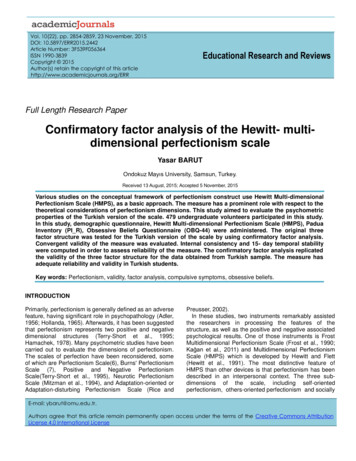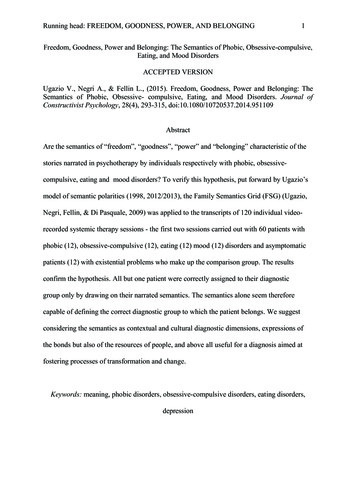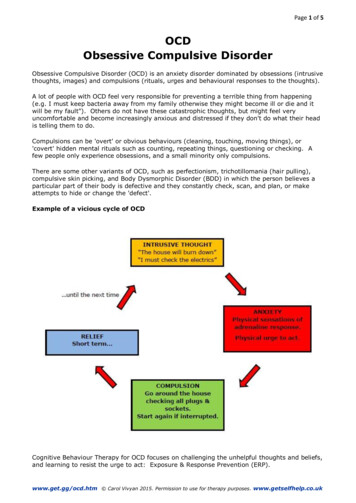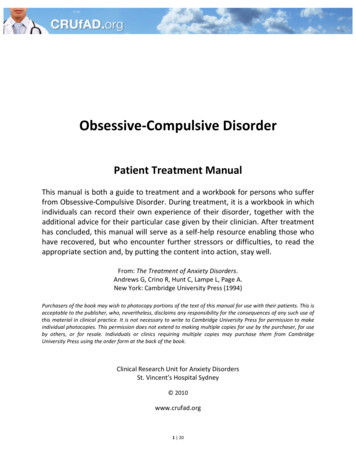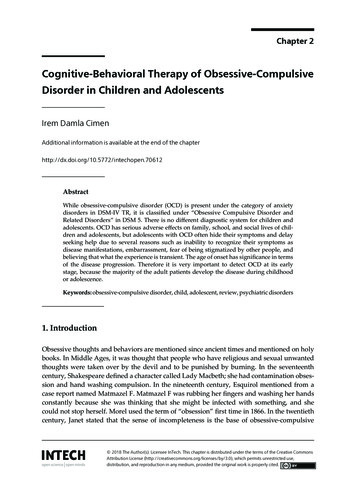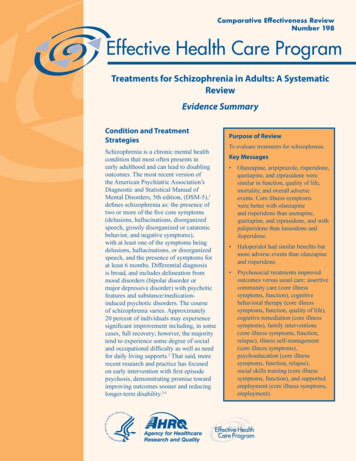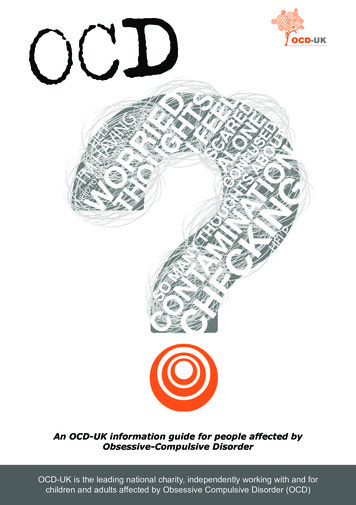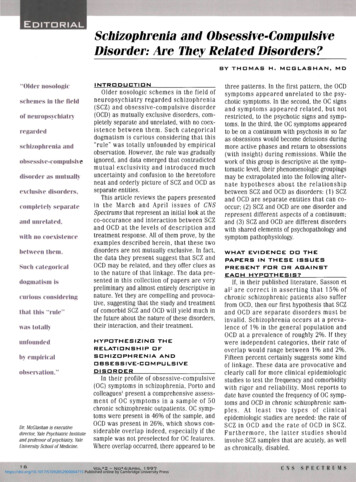
Transcription
EDITORIALSchizophrenia and Obsessive-CompulsiveDisorder: Are They Related Disorders?BYTHDMAS"Older nosologicschemes in the fieldof neuropsychialryregardedschizophrenia andobsessive-compulsivedisorder as mutuallyexclusive disorders,completely separateand unrelated,with no coexistencebetween them.Such categoricaldogmatism iscurious consideringthat this "rule"was totallyunfoundedINTRDDUCTIDNOlder nosologic schemes in the field ofneuropsychiatry regarded schizophrenia(SGZ) and obsessive-compulsive disorder(OGD) as mutually exclusive disorders, completely separate and unrelated, with no coexistence between them. Such categoricaldogmatism is curious considering that this"rule" was totally unfounded by empiricalobservation. However, the rule was graduallyignored, and data emerged that contradictedmutual exclusivity and introduced muchuncertainty and confusion to the heretoforeneat and orderly picture of SGZ and OCD asseparate entities.This article reviews the papers presentedin the March and April issues of CNSSpectrums that represent an initial look at theco-occurance and interaction between SCZand OCD at the levels of description andtreatment response. All of them prove, by theexamples described herein, that these twodisorders are not mutually exclusive. In fact,the data they present suggest that SCZ andOCD may be related, and they offer clues asto the nature of that linkage. The data presented in this collection of papers are verypreliminary and almost entirely descriptive innature. Yet they are compelling and provocative, suggesting that the study and treatmentof comorbid SCZ and OCD will yield much inthe future about the nature of these disorders,their interaction, and their treatment.observation."HYPOTHESIZING THERELATIONSHIP OFSCHIZOPHRENIA ANDOBSESSIVE-COMPULSIVEDISORDERDr. McGlashan is executivedirector, Yale Psychiatric Instituteand professor of psychiatry, YaleUniversity School of Medicine.In their profile of obsessive-compulsive(OC) symptoms in schizophrenia, Porto andcolleagues1 present a comprehensive assessment of OC symptoms in a sample of 50chronic schizophrenic outpatients. OC symptoms were present in 46% of the sample, andOCD was present in 26%, which shows considerable overlap indeed, especially if thesample was not preselected for OC features.Where overlap occurred, there appeared to beby empirical. VDL*2 - Na*4/APRIL 1 997https://doi.org/10.1017/S1092852900004715 Published online by Cambridge University PressH. MCGLASHAN, MDthree patterns. In the first pattern, the OCDsymptoms appeared unrelated to the psychotic symptoms. In the second, the OC signsand symptoms appeared related, but notrestricted, to the psychotic signs and symptoms. In the third, the OC symptoms appearedto be on a continuum with psychosis in so faras obsessions would become delusions duringmore active phases and return to obsessions(with insight) during remissions. While thework of this group is descriptive at the symptomatic level, their phenomenologic groupingsmay be extrapolated into the following alternate hypotheses about the relationshipbetween SCZ and OCD as disorders: (1) SCZand OCD are separate entities that can cooccur; (2) SCZ and OCD are one disorder andrepresent different aspects of a continuum;and (3) SCZ and OCD are different disorderswith shared elements of psychopathology andsymptom pathophysiology.WHAT EVIDENCE DO THEPAPERS IN THESE ISSUESPRESENT FOR OR AGAINSTEACH HYPOTHESIS?If, in their published literature, Sasson etal2 are correct in asserting that 15% ofchronic schizophrenic patients also sufferfrom OCD, then our first hypothesis that SCZand OCD are separate disorders must beinvalid. Schizophrenia occurs at a prevalence of 1% in the general population andOCD at a prevalence of roughly 2%. If theywere independent categories, their rate ofoverlap would range between 1% and 2%.Fifteen percent certainly suggests some kindof linkage. These data are provocative andclearly call for more clinical epidemiologicstudies to test the frequency and comorbiditywith rigor and reliability. Most reports todate have counted the frequency of OC symptoms and OCD in chronic schizophrenic samples. At least two types of clinicalepidemiologic studies are needed: the rate ofSCZ in OCD and the rate of OCD in SCZ.Furthermore, the latter studies shouldinvolve SCZ samples that are acutely, as wellas chronically, disabled.CNSSPECTRIMS
EDITORIALCould SCZ and OCD be one entity? YaryuraTobias and colleagues3 address this questionmost directly by comparing patients with OGDand with SCZ on a variety of symptom profiles. They conclude that SCZ and OCD sharesymptoms and behaviors without losing nosological individuality. This suggests that theassumption of syndromal unity is incorrect.Failure to support this hypothesis probablywould generate little criticism among workersin the field, especially clinicians who regardand usually treat these disorders as different.While overlap between the disorders is frequent, it is also clear that both SCZ withoutOCD and OCD without SCZ are common. Ifthey were but different manifestations of thesame entity, we could probably expect to seefar greater comorbidity, as well as more confluence of one disorder into the other on thebasis of acuteness and/or severity.At the same time, the hypothesis of unityshould not be dismissed. Many of the nonsymptomatic clinical parameters are similarbetween the disorders. Both tend to begin inadolescence and early adulthood, and the ageof onset in both is earlier in males. The timingof onset in both can be variable, ie, gradual oracute, and the longitudinal course can fluctuate in severity depending upon ambient levelsof stress. Episodic exacerbations and longitudinal deterioration can occur in both disorders. Finally, familial patterns are present inboth disorders, ie, higher frequencies of disorder in first-degree relatives versus the general population, and higher frequencies inmonozygotic twins versus dizygotic twins.None of these observations suggest identity,but they do imply that we should be cautiousin rejecting such a possibility.The last hypothesis is a hybrid of the firsttwo: OCD and SCZ are different disorders thatshare elements of symptomatology, psychopathology, and pathophysiology. The dataof Berman and colleagues4 support this view.They assessed 30 schizophrenic patients andfound 25% to have significant OC symptoms.The OC and non-OC schizophrenic patientswere not different on the positive and negative symptoms of schizophrenia, suggestingindependence of OC and psychosis phenomenology. On the other hand, the schizophrenicpatients with OC symptoms scored deviantlyon several neuropsychological subtests thatare typically abnormal in nonschizophrenicOC patients. These tests involve visual-spatialskills, delayed nonverbal memory, and cogniMSSPECTRUM tive shifting abilities. Berman and colleaguessay nothing about how schizophrenic patientswithout OCD score on these subtests; however, given the well-known pervasive deficitsacross neuropsychological profiles amongschizophrenic patients, especially on tests ofexecutive functioning such as the WisconsinCard Sorting Test, it is unlikely the deficitsrecorded here are unique to OCD psychopathology. A study comparing neuropsychological profiles among three groups, ie, SCZwithout OCD, OCD without SCZ, and SCZ withOCD, should be the next step. In the meantime, the study by Berman et al suggests thatwhile there is independence between OCDand SCZ at the symptom level (OC symptomsvs positive and negative psychotic symptoms),there may be less independence at the level ofcognitive functioning.The treatment response data are mixedand confusing. Sasson and colleagues2 foundthat open-label clomipramine reduced OCsymptoms and psychosis in a significant subset of 18 patients with comorbid OCD andSCZ. Bermanzohn et al5 reported cross reactivity of anti-obsessional agents on psychosisin refractory delusional states, arguing thathttps://doi.org/10.1017/S1092852900004715 Published online by Cambridge University y busy practice in #1 regionto live and work in the US.contact: John Holtkamp, MDBlue Ridge Plaza, Suite 2044505 Fair Meadow LaneRaleigh, NC 27607Tel: 919/571-7878Service: 919/755-5201 »4/APRIL 1 9 9 7 !
EDITORIAL"Cross-reactivity ofneuroleplics forOG symptoms hasrecently beenreported in theform of risperidoneaugmentation ofSSRI treatment ofrefractory OCD.Overall, data suggestboth specificity andcross-reactivity,but the evidence isvery preliminary."these might in actuality be OCD in psychoticproportion. Cross-reactivity of neurolepticsfor OC symp-toms has recently been reportedin the form of risperidone augmentation ofSSRI treatment of refractory OCD.6 Overall,data suggest both specificity and cross-reactivity, but the evidence is very preliminary.The field is in need of well-designed augmentation trials that are randomized, placebocontrolled, and blinded. Also, the study ofcomorbid samples demands the presence ofthree comparison groups: the comorbid groupand two control groups consisting of eachdisorder alone.7Perhaps the least contested finding in thisburgeoning field is that comorbidity confers apoor prognosis for both SCZ on OCD courseand OCD on SCZ course.8 This finding does notsupport any of our three hypotheses differentially since all three might predict this finding.It does raise questions as to the degree ofhomogeneity versus heterogeneity of the combined pathology. From a purely descriptive,phenomenologic point of view, there may bereason to favor homogeneity. This rests uponthe assumption that a cardinal feature of mental illness is repetitive mental content, in thesense of there being less variance of content,less freedom and richness of association, truncated complexity of language, more rigid coupling of thought with affective hue, and lessplay of will in the "choice" of mentation. Theseare, almost by definition, the core features ofOCD. A closer look at schizophrenia, especiallythe hallucinations and delusions of psychosis,finds many of the same elements. Delusionsare often preemptory and repetitive in theme,appear linked predictively with certain (usually primitive) affective states, and seem toempty the mind of any interest in other ideasor experiences. Hallucinations, especiallyauditory hallucinations, are often experiencedas repeated phrases with simple sentencestructure and little variation in content. 9Unlike OCD symptoms, they are regarded asexternally generated, but like OCD symptoms,they are unwillingly experienced.Given that both SCZ and OCD bind mentation and empty it of richness and associativedepth, it is no wonder that their co-occurrence can be so devastating. Whether or notthis represents a confluence of similar psychopathology and pathophysioiogy is a highlyrelevant but currently unanswered questionthat awaits pursuit. W &https://doi.org/10.1017/S1092852900004715 Published online by Cambridge University PressREFERENCESPorto L, Bermanzohn PC, Pollack S, Morrissey R, Siris SG.A profile of obsessive-compulsive symptoms in schizophrenia. GNS Spectrums. 1997;3:321-25.Sasson Y, Bermanzohn PC, Zohar J. Treatment of obsessivecompulsive (OC) syndromes in schizophrenia. CNSSpectrums. 1997;4:34-45.Yaryura-Tobias JA, Stevens KP, Neziroglu F, Grunes MS.Obsessive-compulsive disorder and schizophrenia: a phenomenological perspective of shared pathology. CNSSpectrums. 1997;4:21-25.Berman 1, Pappas D, Berman SM. Obsessive-compulsivesymptoms in schizophrenia: are they manifestations of adistinct subclass of schizophrenia? CNS Spectrums.1997:3:34-36.Bermanzohn PC, Porto L, Arlow PB, et al. Are some neuroleptic-refractory symptoms of schizophrenia reallyobsessions? CNS Spectrums. 1997;3:50-57.Saxena S, Wang D, Bystritsky A, Baxter L. Risperidone augmentation of SRI treatment for refractory obsessive-compulsive disorder. J Clin Psychiatry. 1996:57:303-306.McGlashan TH. Borderline personality disorder and unipolar affective disorder: long-term effects of comorbidity. JNervMentDis. 1987;175:467-473.Fenton WS, McGlashan TH. The prognostic significance ofobsessive-compulsive symptoms in schizophrenia. Am JPsychiatry. 1986:143:437-441.Hoffman RE, Oates E, Hafner RJ, Hustig HH. McGlashanTH. Semantic organization of hallucinated "voices" in schizophrenia. Am J Psychiatry. 1994; 151:1229-1230.CNSSPECTRUMS
Now available for the treatment of\Obsessive-Compulsive.Disorder.(sertroline HCl)Please see ZOIOFT (sertraline HCl} prescribing information on adjacent page.https://doi.org/10.1017/S1092852900004715 Published online by Cambridge University Press
ZOLOFT* (sertraline HCl, 50 rag and 100 mg scored tablets) is indicated for the treatment of obsessions and compulsionsin patients with obsessive-compulsive disorder (OCD). The most common side effects are nausea, insomnia, diarrhea,decreased libido, anorexia, dyspepsia, ejaculation failure (primarily ejaculatory delay), tremor, and increased sweating.BRIEF SUMMARYCONTRAINDICATIONS: Concomitant use in patients taking monoamine oxidose inhibitors (MAOIs) is contraindicated.WARNINGS: Cases of serious sometimes fatal reactions have been reported in patients receiving ZOLOFTin combination with on MAOI. Therefore, it is recommended that ZOLOFT not be used in combination withan MAOI, or within 14 days of discontinuing treatment with an MAOI. Similarly, at least 14 days shouldbe allowed after stopping ZOLOFT before starting an MAOI. PRECAUTIONS: General—During premarketingtesting, hypomonia or mania occurred in approximately 0.4% of ZOLOFT treated patients. Activation of mnnia/hypomanin has alsobeen reported in a small proportion of patients with Major Affective Disorder treated with other marketed antidepressant and antiobsessionol drugs. Weight Loss - Significant weight loss may be an undesirable result of treatment with sertraline for somepatients, but on average, patients in controlled trials had minimal,} to 2 pound weight loss, versus smaller changes on placebo.Only rarely have sertraline patients been discontinued for weight loss. Seizure - ZOLOFT has not been evaluated in patients with aseizure disorder. These patients were excluded from clinical studies during the product's premarket testing. No seizures wereobserved among approximately 3000 patients treated with ZOLOFT in the development program for depression. However, 4patients out of approximately 1800 exposed during the development program for obsessive compulsive disorder experiencedseizures, representing a crude incidence of 0.2%. Three of these patients were adolescents, two with o seizure disorder and one witha family history of seizure disorder, none of whom were receiving anticonvulsont medication. Accordingly, like other antidepressantand antiobsessional drugs, ZOLOFT should be introduced with care in patients with a seizure disorder. Suicide -The possibility of asuicide attempt is inherent in depression and may persist until significant remission occurs. Close supervision of high risk patientsshould accompany initial drug therapy. Prescriptions for ZOLOFT should be written for the smallest guantity of tablets consistent withgood potient monagement, in order to reduce the risk of overdose. Weak Uricosuric Effect—ZOtOFT is associoted with a meandecrease in serum uric acid of approximately 7%. The clinical significance of this weak uricosuric effect is unknown, and there havebeen no reports of acute renal failure with ZOLOFT. Use in Patients with Concomitant Illness - Clinical experience withZOLOFT in patients with certain concomitant systemic illness is limited. Caution is advisable in using ZOLOFT in patients with diseasesor conditions that could affect metabolism or hemodynamic responses. ZOLOFT has not been evaluated or used to any appreciableextent in patients with a recent history of myocordial infarction or unstable heart disease. ZOLOFT is extensively metabolized by theliver. A lower or less frequent dose should be used in patients with cirrhosis. Until the pharmacokinetics of ZOLOFT have been studiedin patients with renal impairment and until adequate numbers of patients with severe renal impairment have been evaluated duringchronic treatment with ZOLOFT, it should be used with caution in such patients. Interference with Cognitive and MotorPerformance - In controlled studies, ZOLOFT did not cause sedation ond did not interfere with psycnomotor performance.Hyponatremia - Several cases of hyponatremia have been reported. The hyponatremia appeared to be reversible when ZOLOFTwas discontinued. The majority of these occurrences have been in elderly individuals, some in potients taking diuretics or who wereotherwise volume depleted. Platelet Function - There have been rare reports of altered platelet function and/or abnormalresults from laboratory studies in patients taking ZOLOFT. While there have been reports of abnormal bleeding or purpura in severalpatients taking ZOLOFT, it is unclear whether ZOLOFT had a causative role. Information for Patients: Patients should be toldthat although ZOLOFT has not been shown to impair the ability of normal subjects to perform tasks requiring complex motor ondmental skills in laboratory experiments, drugs that act upon the central nervous system may affect some individuals adversely.Patients should be told that although ZOLOFT has not been shown in experiments with normal subjects to increase the mental andmotor skill impairments caused by alcohol, the concomitant use of ZOLOFT and alcohol in depressed or OCD patients is not advised.Patients should be told that while no adverse interaction of ZOLOFT with over-the-counter (OTC) drug products is known to occur, thepotential for interaction exists. Thus, the use of any OTC product should be initiated cautiously according to the directions of usegiven for the OTC product. Patients should be advised to notify their physician if they become pregnant or intend to become pregnantduring therapy. Patients should be advised to notify their physician if they ore breast-feeding an infant. Laboratory Tests: None.Drug Interactions: Potentinl Effects of Coodministration of Drugs Highly Bound to Plnsma Proteins -Because sertraline is tightly bound to plasma protein, the administration of ZOLOFT to a patient taking another drug which is tightlybound to protein (e.g., warfarin, digitoxin) may cause a shift in plasma concentrations potentially resulting in an adverse effect.Conversely, adverse effects may result from displacement of protein-bound ZOLOFT by other tightly bound drugs. Accordingly, profhrombin time should be carefully monitored when ZOLOFT therapy is initiated or stopped. Cimetidine - In a study assessing disposition of ZOLOFT (100 mg) on the second of 8 days of cimetidine administration (800 mg daily), there were increases in ZOLOFTmean AUC (50%), Cmax (24%) and half-life (26%) compared to the placebo group. The clinical significance of these changes isunknown. CNS Active Drugs - In a study comparing the disposition of intravenously administered diazepam before ond after21 days of dosing with either ZOLOFT (50 to 200 mg/day escalating dose) or placebo, there was a 32% decrease relative to baseline in diazepam clearance for the ZOLOFT group compared to a 19% decreose relative to baseline for the plocebo group (p 0.03).There was a 23% increase in Tmax for desmethyldiazepam in the ZOLOFT group compared to a 20% decrease in the placebo group(p 0.03). The clinical significance of these changes is unknown. In o placebo-controlled trial in normal volunteers, the administration of two doses of ZOLOFT did not significantly alter steady-state lithium levels or the renal clearance of lithium. Nonetheless, atthis time, it is recommended that plasma lithium levels be monitored following initiation of ZOLOFT therapy with appropriate adjustments to the lithium dose. The risk of using ZOLOFT in combination with other CNS active drugs has not been systematically evaluated. Consequently, caution is advised if the concomitont administration of ZOLOFT and such drugs is required. There is limited controlled experience regarding the optimal timing of switching from other antidepressants to ZOLOFT. Care and prudent medical judgment should be exercised when switching, particularly from long-acting agents. The duration of an appropriate washout period whichshould intervene before switching from one selective serotonin reuptoke inhibitor (SSRI) to another has not been established.Drugs Metabolized by P450 3A4 - In two separate in vivo interaction studies, sertraline was coadministered with thecytocnrome P450 3A4 substrates, terfenadine or carbamazepine, under steody state conditions. The results of these studies demonstrated that sertraline coadministration did not increase plasma concentrations of terfenadine or carbamazepine. These data suggestthat sertraline's extent of inhibition of P450 3A4 activity is not likely to be of clinical significance. Drugs Metabolized byP450 2D6 - Many antidepressonts, e.g., the SSRIs, including sertratine, and most tricyclic antidepressants inhibit the biochemicalactivity of the drug metabolizing isozyme cytochrome P450 2D6 (debrisoquin hydroxylase), and, thus, may increase the plasmaconcentrations of condministered drugs that are metabolized by P450 2D6. The drugs for which this potential interaction is of greatest concern are those metabolized primarily by 2D6 and which hove a narrow therapeutic index, e.g., the tricyclic antidepressantsand the Type 1C antiarrhythmics propafenoneond flecainide. The extent to which this interaction is an important clinical problemdepends on the extent of the inhibition of P450 2D6 by the antidepressant and the therapeutic index of the coadministered drug.There is variability among the antidepressants in the extent of clinically important 2D6 inhibition, and in fact sertraline at lowerdoses has a less prominent inhibitory effect on 2D6 than some others in the class. Nevertheless, even sertraline has the potential forclinically important 2D6 inhibition. Consequently, concomitant use of a drug metabolized by P450 2D6 with ZOLOFT may requirelower doses than usually prescribed for the other drug. Furthermore, whenever ZOLOFT is withdrawn from co-therapy, an increaseddose of the coadministered drug may be required (see Tricyclic Antidepressants under PRECAUTIONS).Tricyclic Antidepressunts (TCAs) - The extent to which SSRI-TCA interactions may pose clinical problems will depend on thedegree of inhibition and the pharmocokinetics of the SSRI involved. Nevertheless, caution is indicated in the condministration ofTCAs with ZOLOFT because sertraline may inhibit TCA metabolism. Plasma concentrations of TCAs may need to be monitored, and thedose of TCA may need to be reduced, if a TCA is co-administered with ZOLOFT (see Drugs Metabolized by P45O 2D6 under PRECAUTIONS). Hypoglycemic Drugs - In o placebo-controlled trial in normal volunteers, administration of ZOLOFT for 22 days (including 200 mg/day for the final 13 days) caused a statistically significant 16% decrease from baseline in the clearance of tolbutamidefollowing an intravenous 1000 mg dose. ZOLOFT administration did not noticeably change either the plasma protein binding or theapparent volume of distribution of tolbutamide, suggesting that the decreased cleorance was due to a change in the metabolism ofthe drug. The clinical significance of this decrease in tolbutamide clearance is unknown. Atenolol - ZOLOFT (100 mg) whenadministered to 10 healthy male subjects had no effect on the beta-adrenergic blocking ability of atenolol. Digoxin - In a placebocontrolled trial in normal volunteers, administration of ZOLOFT for 17 days (including 200 mg/day for the last 10 days) did notchange serum digoxin levels or digoxin renol clearance. Microsomol Enzyme Induction - Preclinical studies have shownZOLOFT to induce hepatic microsomal enzymes. In clinical studies ZOLOFT was shown to induce hepatic enzymes minimally as determined by a small (5%) but statistically significant decrease in antipyrine half-life following administration of 200 mg/day for 21days. This small change in antipyrine half-life reflects a clinically insignificant change in hepatic metabolism. ElectroconvulsiveTherapy - There ore no clinical studies establishing the risks or benefits of the combined use of electroconvulsive therapy (ECT)and ZOLOFT. Alcohol -Although ZOLOFT did not potentiate the cognitive and psychomotor effects of alcohol in experiments withnormal subjects, the concomitant use of ZOLOFT and alcohol in depressed or OCD patients is not recommended. Cardnogenesis,h\utagenesis, Impairment of fertility: Lifetime carcinogenicity studies were carried out in CD-I mice and Long-Fvons rats atdoses up to 40 mg/kg/day. These doses correspond to 1 times (mice) and 2 times (rats) the maximum recommended human dose(MRHD) on a mg/m 2 basis. There was a dose-related increase of liver adenomas in male mice receiving sertraline at 10-40 mg/kg(0.25 -1.0 times the MRHD on a mg/m 2 basis). No increase was seen in female mice or in rats of either sex receiving the sametreatments, nor was there an increase in hepatocellular carcinomas. Liver adenomas have a variable rate of spontaneous occurrencein the CD-I mouse and are of unknown significance to humans. There was an increase in follicular adenomas of the thyroid in femalerats receiving sertraline at 40 mg/kg (2 times the MRHD on a mg/m 2 basis); this was not accompanied by thyroid hyperplasia.While there was an increase in uterine odenocarcinomas in rats receiving sertraline at 10-40 mg/kg (0.5 - 2.0 times the MRHD ona mg/m 2 basis) compared to placebo controls, this effect was not clearly drug related. Sertraline had no genotoxic effects, with orwithout metabolic activation, based on the following assays: bacterial mutation assay; mouse lymphomo mutation assay; and testsfor cytogenetic aberrations in vivo in mouse bone marrow and in vitro in humon lymphocytes. A decrease in fertility was seen in oneof two rat studies at a dose of 80 mg/kg (4 times the moximum human dose on a mg/m 2 basis).Pregnancy—PregnancyCategory 0 Reproduction studies have been performed in rats and rabbits at doses up to 80 mg/kg/day and 40 mg/kg/day,respectively. These doses correspond to approximately 4 times the maximum recommended human dose (MRHD) on o mg/m 2basis. There was no evidence of teratogenicity at any dose level. When pregnant rats and robbits were given sertraline during theperiod of organogenesis, deloyed ossification was observed in fetuses at doses of 10 mg/kg (0.5 times the MRHD on a mg/m 2basis) in rats and 40 mg/kg (4 times the MRHD on a mg/m 2 basis) in rabbits. When femole rats received sertraline during the lastthird of gestation and throughout lactation, there was an increase in the number of stillborn pups and in the number of pups dyingduring the first 4 days after birth. Pup body weights were also decreased during the first four days after birth. These effects occurredat a dose of 20 mg/kg (1 times the MRHD on a mg/m 2 basis). The no effect dose for rat pup mortality was 10 mg/kg (0.5 timesthe MRHD on a mg/m 2 basis). The decrease in pup survival was shown to be due to in utero exposure to sertraline. The clinical significance of these effects is unknown. There ore no adequate and well-controlled studies in pregnant women. ZOLOFT should be usedduring pregnancy only if the potential benefit justifies the potential risk to the fetus. Lobor ond Delivery - The effect of ZOLOFTon labor and delivery in humans is unknown. Nursing Mothers - It is not known whether, and if so in what amount, sertralineor its metabolites are excreted in human milk. Becouse mony drugs are excreted in humon milk, caution should be exercised whenZOLOFT is administered to a nursing woman. Pediatric Use - Safety and effectiveness in children have not been established.Geriatric Use - Several hundred elderly patients have participated in clinical studies with ZOLOFT. The pattern of adverse reactions in the elderly was similar to that in younger potients. ADVERSE REACTIONS Commonly Observed: Among patientstreated with ZOLOFT in placebo-controlled premarketing studies, the most commonly observed odverse events associated with theuse of ZOLOFT and not seen at an equivalent incidence among placebo-treated patients were: gastrointestinal comploints, includingnauseo (26% vs 12%), diarrhea/loose stools (18% vs 9%) and dyspepsia (6% vs 3%); tremor (11% vs 3%); dizziness (12% vs7%); insomnia (16% vs 9%); somnolence (13% vs 6%); increased sweating (8% vs 3%); dry mouth (16% vs 9%); and male sexual dysfunction (16% vs 2%), primarily ejaculatory delay. In placebo-controlled clinical trials for OCD, adverse events observed at anincidence of at least 5% for ZOLOFT and at an incidence that was twice or more the incidence among placebo-treated potients included: nauseo (30% vs 11%), insomnia (28% vs 12%), diarrhea (24% vs 2%), decreased libido (11% vs 2%), anorexia (11% vs2%), dyspepsia (10% vs 4%), ejaculation failure (primarily ejaculatory delay) (17% vs 2%), tremor (8% vs 1%), ond increasedsweating (6% vs 1%). Associated with Discontinuation ol Treatment: Fifteen percent of 2710 patients who receivedZOLOFT in premarketing multiple dose clinical trials discontinued treatment due to an adverse event. The more common events(reported by at least 1 % of subjects) associated with discontinuation included agitation, insomnia, male sexual dysfunction (primarily ejaculatory delay), somnolence, dizziness, headache, tremor, anorexia, diorrhea/loose stools, nausea, and fatigue. In placebocontrolled clinical trials for OCD, 10% of patients treated with ZOLOFT discontinued treatment due to on adverse event. The morecommon events were nausea, insomnia, and diarrhea. Other bents Observed Daring the Premarketiag Evaluationof ZOLOFT: During its premarketing assessment, multiple doses of ZOLOFT were administered to approximately 2700 subjects.Events a
OBSESSIVE-COMPULSIVE DISORDER In their profile of obsessive-compulsive (OC) symptoms in schizophrenia, Porto and colleagues1 present a comprehensive assess-ment of OC symptoms a i sampln e of 50 chronic schizophrenic outpatients. OC symp-toms were present in 46% of
